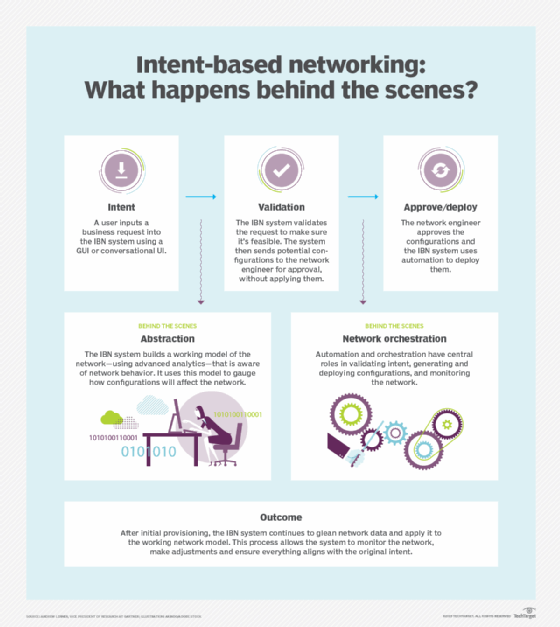
kentoh - Fotolia
Benefits of intent-based networking for modern networks
Intent-based networking can benefit network teams working remotely with increased workloads due to COVID-19. Benefits include reduced human error and automated manual tasks.
The networking industry has been on a long journey to make networks easier to deploy, operate and troubleshoot. Automating network operations is more critical than ever, given employees' reliance on the network and the limited access IT personnel have to physical resources due to the COVID-19 pandemic.
Networking operations are continuously complex, as these operations require manual intervention and highly trained personnel. New software networking tools can reduce the number of manual tasks for network teams, suggest possible solutions to problems and better understand a process's or application's intent.
Tools for intent-based networking (IBN) -- a networking approach that aims to automate a network's administrative tasks -- provide significant benefits to IT productivity, including error reduction, improved security and more rapid resolution of trouble tickets.
Effect of COVID-19 on network requirements
The spread of COVID-19 has had several effects on network operations. First, it has required IT teams to instantly support access to critical applications for employees working from distributed locations. It has also increased the demand for cloud- or SaaS-based applications, and it has restricted and limited IT teams' physical access to network elements in the data center, campus or branch office.
To support distributed workforces, networks must always be operational and secure. Network agility is critical to adjust to rapidly changing business conditions. IT and network employees working from home or other remote locations must be able to operate, adjust and troubleshoot network infrastructure from those locations.
As IT teams are often busy supporting the remote workforce, network automation is critical to reduce time-consuming manual operations, such as identifying causes of application slowdowns. That's where IBN fits in.
Benefits of intent-based networking and real-world examples
IBN software touts the ability to reduce manual tasks, such as provisioning network services, changing network configurations or implementing new security policies.
Benefits of intent-based networks include the following:
- Quickly turn up new physical locations, including branch and home networks.
- Reduce manual tasks, such as pushing configuration changes to hundreds or thousands of network devices.
- Identify causes of network or application slowdowns.
- Reduce human errors, which can create opportunities for attackers to penetrate the network.
The goal of intent-based networks is to fully automate network operations, as well as implement security and prioritization policies associated with a wide variety of applications, users and locations.

Companies have already begun to adopt IBN. Two real-world examples of IBN implementation come from Terracon and MacStadium.
Terracon implements Gluware technology
Gluware Inc. is a California-based networking startup focused on network automation. Terracon is a U.S.-based engineering firm that consistently adds, moves or discontinues operations at specific locations. Terracon manages its distributed operations remotely with centralized IT staff and supports a multivendor network, including Cisco.
Terracon implemented Gluware to help automate its network operations -- for example, to push out a standard network configuration to remote locations. Terracon reported benefits such as improved network reliability and reduced need for manual network operations.
MacStadium implements Cisco DNA Center network automation
MacStadium Inc. is an Atlanta-based IT service firm focused on Apple services. It needs to monitor and maintain its growing data center network infrastructure, which is spread across eight colocation facilities in three countries.
MacStadium recently established a Virtual Extensible LAN with Cisco's Nexus 9000 switches and Data Center Network Manager (DCNM) software. This enables MacStadium to stretch its Layer 2 and Layer 3 networks between data centers for multisite connectivity and configuration. The DCNM software provides configuration, automation and control of the data center switching infrastructure, as well as real-time visibility into the network's health.
Other vendors to watch in the IBN market include Apstra, Forward Networks, Aruba Networks -- a Hewlett Packard Enterprise company -- and VMware.
Recommendations for IT leaders
Intent-based networks are necessary to address configuration, management and automation requirements for most organizations. As these organizations rely more on their networks and may lack physical access to network infrastructure, IT teams require increasingly powerful centralized management tools.
IBN technology is starting to show promise in its ability to automate previously manual tasks and provide insight into current network operations. The self-operating or self-correcting network is still far away, but IT teams can currently implement incremental gains in automation. And these capabilities will increase as intent-based technologies improve over time.







